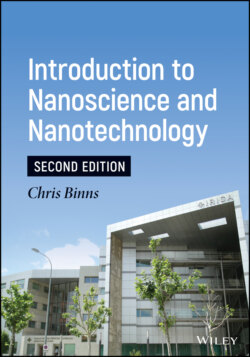Читать книгу Introduction to Nanoscience and Nanotechnology - Chris Binns - Страница 14
I.3 Radical Nanotechnology
ОглавлениеFinally, the most far‐reaching version of nanotechnology, described as Radical Nanotechnology by Richard Jones, is the construction of machines whose mechanical components are the size of molecules. The field has bifurcated into two distinct branches, that of molecular manufacturing in which macroscopic structures and devices are built by assembling their constituent atoms, and nanorobots or nanobots, which are invisibly small mobile machines. Molecular manufacturing was originally proposed by the Nobel laureate, Richard Feynman in his famous lecture in 1959, and was subsequently advocated with much enthusiasm by Eric Drexler [8]. In 1990, the IBM research laboratories in Zurich demonstrated that they could move and position individual atoms using a scanning tunneling microscope (STM – see Chapter 5, Section 5.4.2) lending support to the idea that molecular manufacturing may, at least in principle, be possible. The problems and the emergence of some enabling technologies for molecular manufacturing are presented in Chapter 9.
Nanobots have generated a good deal of controversy, especially ones that can play atomic lego and build anything out of atoms lying around. If this was possible, then one could, in principle, build a nanobot that moved around exploring the surface it occupied. If it was equipped with an assembler that could assemble atoms and molecules, it could make a copy of itself by rooting around and finding the atoms it needed to reproduce. Since each nanobot could make multiple copies of itself, the population could increase exponentially and would quickly produce a sufficiently vast army to build macroscopic objects. Drexler himself pointed out the doomsday scenario where the nanobots multiply out of control like a virus and eventually exist in such vast numbers that they could rearrange the atoms of the planet to produce a kind of “grey goo.” Unfortunately, this scenario has tended to hijack discussions on radical nanotechnology, and since the two branches of radical nanotechnology have been melded together in the public debate there is a general feeling that all radical nanotechnology is dangerous. The reality is that exponentially self‐replicating machines are not required for molecular manufacturing [9], and nanobots do not need to be built with assemblers to self‐replicate in order to perform useful functions, as shown in Chapter 9, Section 9.3 for the case of medical nanobots.
There is a scientific debate about whether this technology is feasible, even in the long term, or indeed desirable, but the discussion has moved on from generalities to a consideration of the detailed processes required for molecular manufacturing (see Chapter 9 and the references therein). A frequently proposed argument in favor of radical nanotechnology is that it already exists in all living things. Biological cells are filled with what may be regarded as nano‐machines and molecular assemblers. Biology, however, is very different to the nanoscale process‐engineering path envisaged by radical nanotechnologists, as explained in Soft Machines [2]. It is fair to say that both the feasibility and timescale of radical nanotechnology divides the community. The point is that, while incremental nanotechnology exists and evolutionary nanotechnology is just coming into the frame, radical nanotechnology, if feasible, is probably decades away. Whatever the twists and turns of the debate, once we get away from the argument over nanobots, there is no doubt that the ability to produce nano‐machines and achieve safe non‐exponential molecular manufacturing will reap enormous benefits.
It is possible that the solution to some of the more difficult technological problems involved with radical nanotechnology may arise from a better fundamental understanding of the true nature of empty space. Quantum theory predicts new types of force at very short distance scales (nanometers) arising directly out of the quantum properties of vacuum. Although we can only detect these forces with very sensitive instruments (the tools of nanotechnology in fact – see Chapter 10), to a nanoscale machine whose components are within nanometers of each other, these forces will be as natural as a part of their environment as gravity is to us. Research on these forces and how to utilise them in nanotechnology is already being undertaken by several research groups worldwide. This may be one of the missing links between biology and radical nanotechnology, that is, natural systems, whose inner workings happen on the same scale as nanomachines have evolved over billions of years and must have utilised all available forces including the exotic ones.
